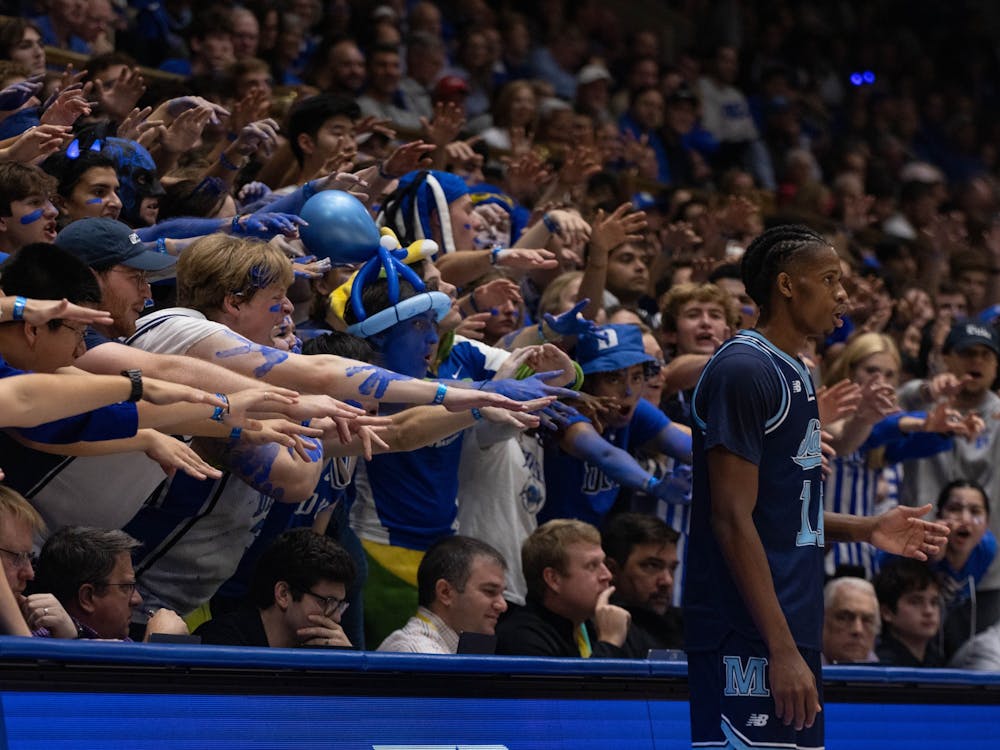In 2003, several Duke students discovered that Maryland guard Steve Blake had written an essay on the Johnny Rockets restaurant chain. A so-called “Cameron Crazie” drove all the way to Washington, D.C., stopping at every location to collect the fast-food burger joint’s signature paper hats. When Blake showed up for Maryland’s game against Duke, he found one atop the head of every fan in the student section.
It wasn’t unusual behavior. The student fans of Cameron Indoor Stadium had already developed a reputation as some of the most dedicated in college basketball, known for their raucous energy and creative stunts.
“At the end of the day, nothing they did surprised me,” former head coach Mike Krzyzewski told The Chronicle.
‘A HEARTY WELCOME’
In 1980, Krzyzewski arrived in Durham to a lackluster men’s basketball team and an uninspired student fanbase. Though Bill Foster finished his reign with three strong years, Duke went 38-47 in Krzyzewski’s first three seasons. Student support was far from the frenzy now associated with Cameron Indoor Stadium, and the new, young head coach wasn’t exactly drawing crowds.
The students weren’t going to Krzyzewski, so Krzyzewski went to them.
“What I tried to do is go out to fraternities, sororities … and [I] asked them for support,” Krzyzewski said. “I just wanted, especially when we were losing, for them to get to know me, not just see me on the sidelines or getting our butts beat. [I wanted them to see] that we [were] trying to build something, and we wanted them to be a part of the process to build it.”
In Krzyzewski’s fourth season, the team started winning, and the students bought in. Leading the charge were a Bunch of Guys — BOG. The fraternity-alternative living group was indeed just a bunch of guys, and they loved Duke basketball. The “Boggers” would station themselves behind the opponent’s bench — which used to be part of the undergraduate student section — and heckle visiting teams.
“The ACC was filled with incredible stars and villains,” said Eric Rothschild, who spent 1986-89 as a member of the group. “There were people in trouble over shoplifting or cheating on a test. The Cameron Crazies just had so many targets.”
With endless material at their fingertips, the Crazies entertained themselves with a wide variety of “antics,” according to Krzyzewski. This included throwing tennis balls over the court from Section 19 to 17 — back when the students claimed both — and jangling keys at opposing players with criminal speeding records. When N.C. State forward Lorenzo Charles was accused of stealing pizzas, the Boggers and their fellow students threw empty pizza boxes onto the court. Chris Washburn, accused of stealing a stereo, had records flying in his direction. Students tossed twinkies at Georgia Tech’s Dennis Scott and uncooked noodles at his teammate Craig Neal.
“They would throw too many things on the court,” Krzyzewski said.
The Crazies were at their rowdiest, at least according to the University, on Jan. 14, 1984. Maryland forward Herman Veal had recently been reinstated by the team after sexual assault allegations. The students, with the same independent creativity and spontaneity that Krzyzewski raved about, tossed condoms and women’s underwear onto the court. The Washington Post took note, and suddenly the Crazies were under national scrutiny.
The University’s president at the time was Terry Sanford, known as “Uncle Terry” to the students. Although he supported the students, Sanford wrote the “Avuncular Letter” to the Crazies; he knew a line had been crossed.
“I suggest that we change. Talk this matter over in your various residential houses. Think of something clever but clean, devastating but decent, mean but wholesome, witty and forceful but G-rated for television, and try it at the next game,” Sanford wrote in the letter.
That next game in Cameron Indoor happened to be against top-ranked North Carolina. The students took Uncle Terry’s words to heart.
“We all made halos out of aluminum foil and wore halos into the game,” Kim Reed, Trinity ‘86, said. “[We] had signs that said, ‘Welcome honored guests. We're pleased to have you, Dean Smith,’ you know. ‘Referees are never wrong,’ things like that.”
The Crazies were “good” that game, politely disagreeing with the referees instead of shouting profanities. One sign offered “A HEARTY WELCOME TO DEAN SMITH,” and students attempted to deliver the rival coach a bouquet of flowers before tipoff. When North Carolina players stepped up for free throws, students remained quiet and raised signs that read ‘Please miss.’ The Crazies waved and smiled at the Tar Heels even while Duke lost the game.
“I always wanted them to cheer for us, not against them,” Krzyzewski said.
‘Krzyzewskiville: Established 1986’
In 1986, a game of quarters changed the Crazies’ trajectory. While tossing coins the Tuesday night before the North Carolina game, several residents of the Mirecourt selective living group began debating what time they should get in line to reserve second-row seats. Some suggested Saturday night, expecting high attendance at Sunday’s game. Others lobbied for Saturday morning. It didn’t take long to work backwards through the week, and the group eventually reasoned that they should head to Cameron right away.
Get The Chronicle straight to your inbox
Sign up for our weekly newsletter. Cancel at any time.
Reed, a senior, drove to the U-Haul store in search of pup tents the group could pitch for temporary shelter the next morning. After setting up on the sidewalk in front of the student entrance, she and her friends took turns camping out. They soon decided their tent city needed a name: Krzyzewskiville.
“It was sleeting almost the entire time, just freezing cold, well below 32 degrees,” Reed remembered. “But we stuck it out. We just thought it was funny. We didn't have any intention of starting anything.”
Krzyzewski remembered it differently: “It wasn’t just pitching a tent. It was like Woodstock.”
“There were hot tubs out there,” he added.
Reed graduated and went on to law school at the University of Virginia, but drove down the following year to watch the rivalry game. Some of her friends, who had been juniors during the first tenting stint, camped out again.
That’s when the TV stations picked up on the story. An ABC affiliate in Durham drove out to the stadium to film for two days, and other students began bringing tents and golf umbrellas of their own. The frenzy — which lacked rules or group numbers — was still far from organized. But as Reed returned each year for the game, she noticed more and more tents cropping up on the lawn.
“There were only, you know, 40, 50, 60 … I thought it would peter out,” Reed said. “What really got out of hand is when people started pitching tents the day after fall exams ended. That was just insane.”
As demand for coveted spots in K-Ville grew, so did regulation. Soon, students had to wait until the new year to pitch tents. Even then, construction began at 12:01 a.m.
“The rules have grown up to kind of circumscribe the insanity,” Reed said. “There have been years when hundreds of Duke students had mono because it went around K-Ville … so when that started happening, I was like, ‘Oh my God, this is crazy.’”
‘The great home court’
As Duke basketball gained national attention, so did its most loyal fans. The Boggers, still cheering in full force, leveraged Cameron’s courtside proximity to pester players with tailored insults and yell from behind the visitors’ bench whenever possible.
“One of our biggest things was manic screaming during timeouts,” Rothschild said. “So much so that some teams started to pull their team onto the court to huddle up for timeouts, rather than sit on the bench where we were making all that noise.”
The Boggers started a couple other timeless Cameron traditions, including the jumps before tipoff and the infamous “See ya!” directed at fouled-out players. North Carolina center Eric Montross, who the Crazies thought resembled Frankenstein, inspired the high-pitched “whoop” and arm motions after turnovers.
Members of the Boggers also mastered the art of dirt sheet insults long before physical ones began circulating. They would dig up any information they could; no target was off-limits.
After one opposing coach’s wife complained about taunting, the Boggers received a temporary ban from their usual seats behind the bench in Section 19. They reluctantly headed across the court for the next few games, chanting “Our seats” to make their displeasure known. That earned BOG president a meeting with Krzyzewski — but he remained sympathetic to the Boggers — and the group soon returned to its rightful spots.
“There was some affection, some appreciation, that we were a big contributor to making Cameron the wild place — the great home court — that it was,” Rothschild said. “I would say BOG was the rowdy and goofiest edge … sort of like the vanguard of the escalation of the Cameron Crazies.”
The Boggers had other memorable moments as well. When Steve Hale played in Cameron with a collapsed lung in 1986, they taunted him with an “in-Hale, ex-Hale” chant. That replaced the famous “airball” chant, which originated against North Carolina in 1979 (Six years before the introduction of the shot clock, the Tar Heels had held the ball for 12 minutes before Rich Yonakor finally took a left-handed shot that sailed completely over the basket).
BOG camped outside for most games, and they weren’t afraid to mess with players. One member found himself kicked out of Cameron after stealing the ball from Arizona’s Brian Williams in warm-ups and driving past him for a layup.
The group developed a close relationship with the Krzyzewskis over the years — sometimes getting lunch with Mickie, Coach K's wife, or inviting the team to quad barbecues. However, BOG eventually disbanded in 1990 after accumulating too many penalty points under the University’s system.
‘Tent check!’
By 1990, the team was good — really good. The dedication from the Crazies was just as strong. Reed’s successors were still pitching tents outside Cameron Indoor, and now there were a lot more of them.
Cathy Dipierro, née Corbitt, was an active participant as soon as she stepped on campus. As a freshman, she and her friends set up their tent outside Cameron Indoor. They decorated the front of it with duct tape, and wrote their number in line on the side — it was easier to keep track that way.
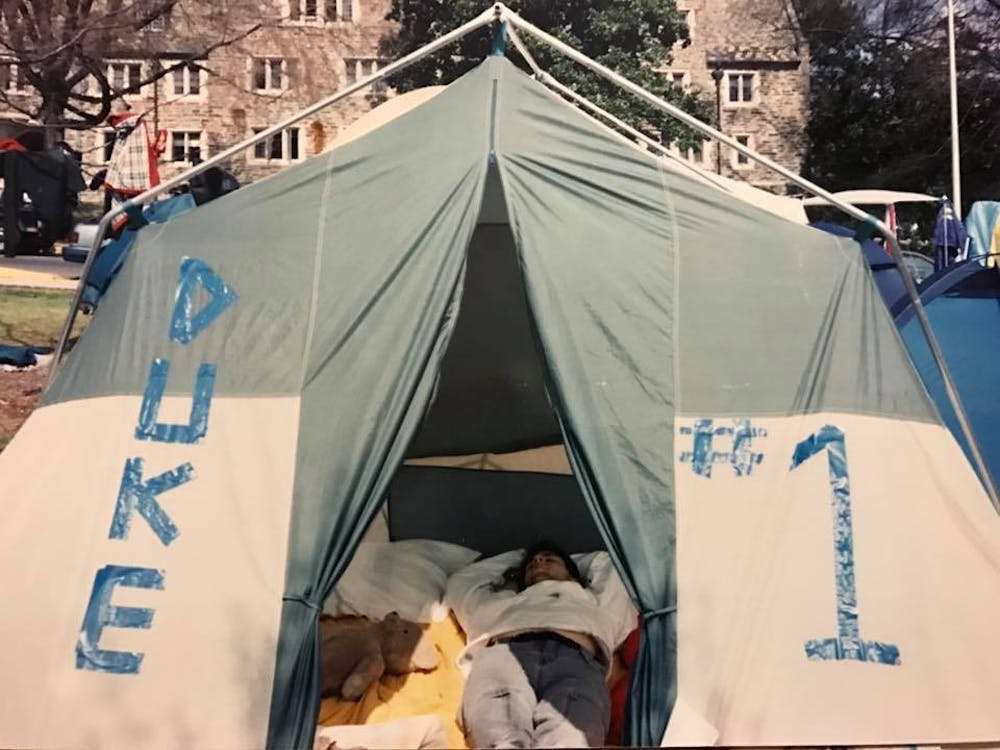
“You went out, you pitched a tent. It was kind of like the honor system,” Dipierro said.
Four years after its inception, tenting became tradition. Line monitors existed, but they were usually tenters who volunteered to help keep order.
As a sophomore, Dipierro started helping the line monitors.
“I used to go out at like, 2:30 in the morning with my flashlight and be like, ‘Bang, bang. Tent check!’” she said. “I had my clipboard, my list of everybody in every tent … It was a self-governing organization.”
There was no temperature or weather grace, no established order or regulation. The students camped outside no matter what — except for one instance, when someone let them inside.
That night, in the middle of winter during Dipierro’s tenure, it poured.
“We literally had [two inches of] water in the bottom of our tent and no way to get rid of it,” Dipierro said. “I think they just took pity on us.”
The tenters were ushered out of Krzyzewskiville and into the Cameron Indoor concourse. They piled in, filling each nook and cranny along the walkway with their soaking wet belongings. By the time Dipierro and her roommates made it inside, it was full. There was nowhere else to lay down on the concourse.
They had nowhere to go but inside. So Dipierro and her roommates walked into the stands, climbed up onto a camera platform and tucked themselves in.
“I remember thinking to myself, ‘How is this my life? This is the greatest thing that's ever happened to me,’” Dipierro said.
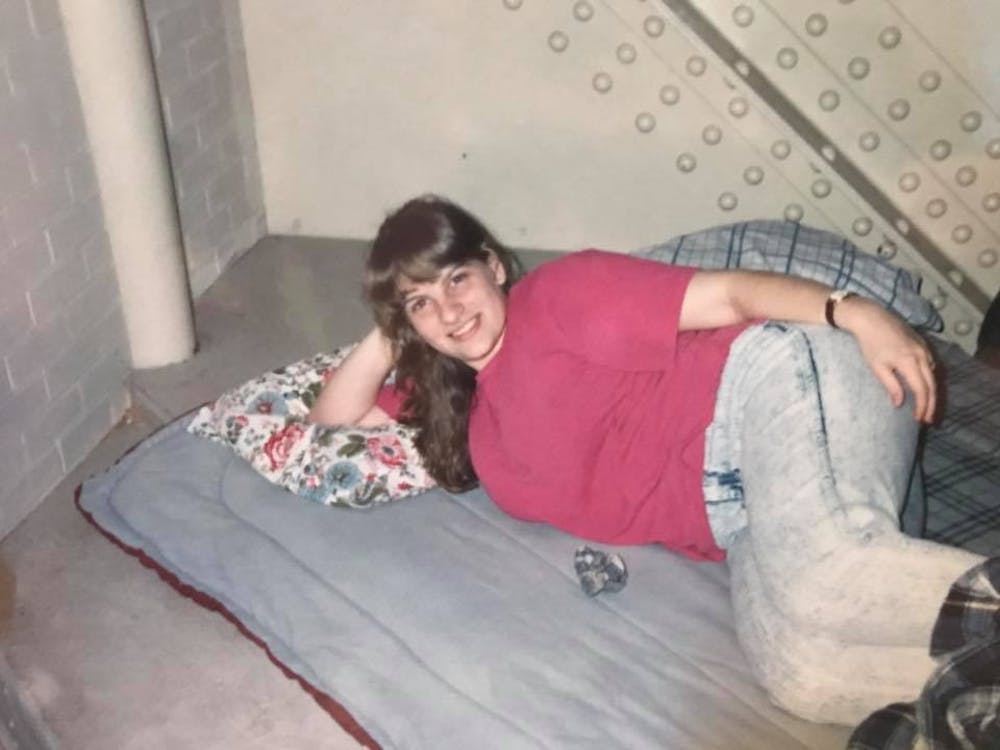
Dipierro and her classmates lived through the heartbreak of the national title loss to UNLV and the redemption in the 1991 Final Four. She and her roommate Pam Peters watched Christian Laettner’s shot in the Philadelphia Spectrum. Just as students did in 2022, Dipierro and Peters stood on the court in Cameron Indoor with the Final Four games projected onto the big screen. Everyone jumped and screamed as if their team was playing right in front of them.
When Duke won, the entire Durham community packed the stadium to welcome the champions home.
‘Oh, baby!’
That excitement faded as the championship years passed. By the time 2006 rolled around, the Crazies needed something new.
A group of line monitors found unlikely inspiration in a beer commercial. After watching actors hold up various basketball sign pairings — “D” and a fence, “B” and a lock — they decided to brainstorm their own combination for Duke’s next game. One senior named Dan Baum wanted to make signs with “O” and a baby, in reference to the catchphrase of street basketball commentator Duke Tango. His friends disagreed, opting for the letter “S” and a lamb.
“I just didn’t see that really working,” Baum remembers. “So they tried out S-Lam, and I drove to Walmart.”
The store he stopped at had one baby left in stock. It happened to be wearing a light blue onesie, so Baum wrote “GTHC” across the front and covered it with a child-sized Duke T-shirt. The doll was game-ready by the time S-Lam fizzled out with students.
It made its debut at home against George Mason Dec. 19, 2006. The Crazies immediately fell in love with their new child.
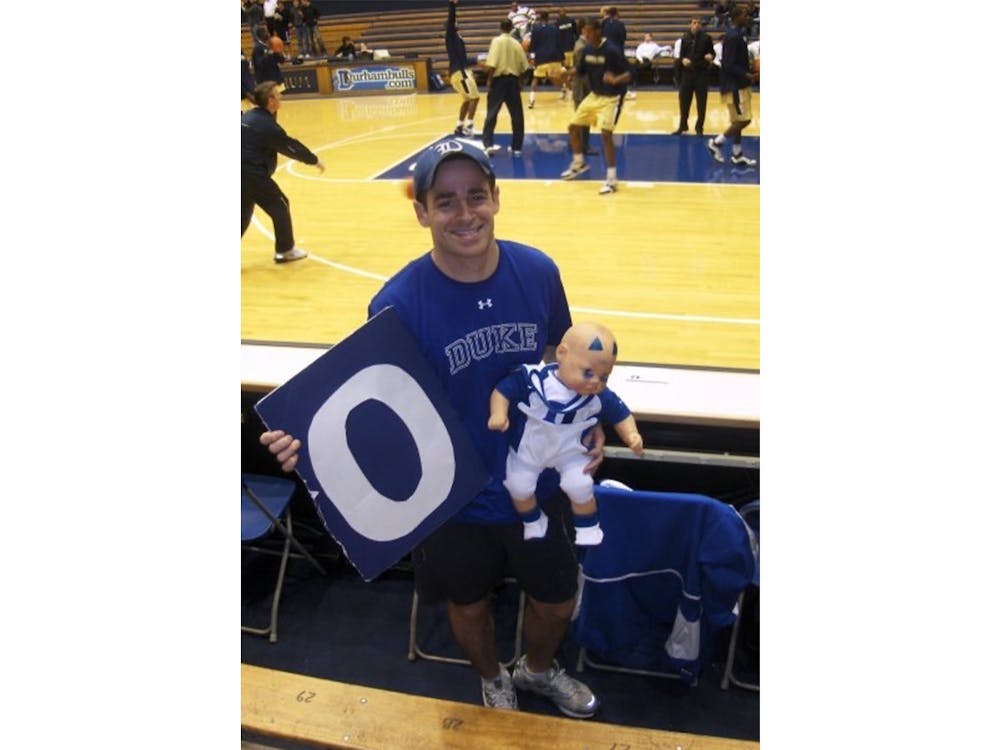
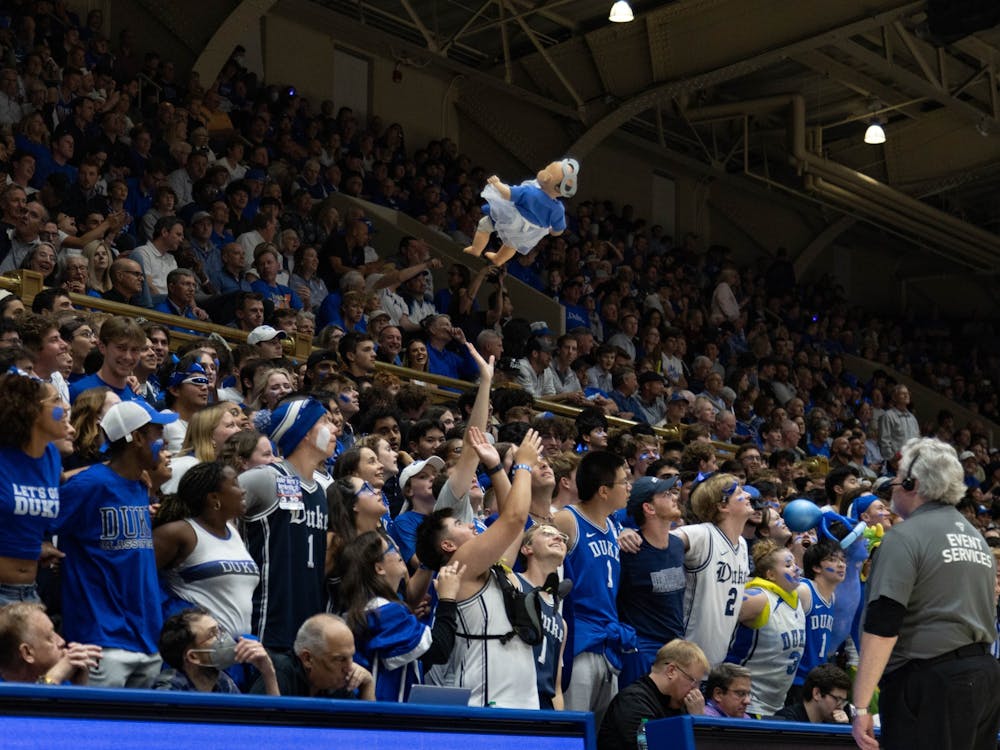
Some Blue Devil fans had concerns. Baum’s former summer employer, Kevin Trapani, approached him after a few games. He worried about the appearance of Duke students bullying a North Carolina baby.
“He gave me a $20 bill and told me to fix it,” Baum said. “So I, just cracking up the entire time, went to the Duke Store after the game, when it was packed, and tried onesies on the baby doll.”
Once satisfied he had averted any PR crises, Baum made sure the baby appeared for the rest of the season. He passed it down to a line monitor in the class below him, who did the same after her own graduation. Over the years, the sign with the “O” eventually disappeared, and line monitors found new ways to involve the baby in Crazie traditions. Baum soon lost track of the lineage.
“Every time I come back, every time the baby makes it on TV, it's always fun to see what's happening,” Baum said. “The students have come up with great things to do that I had no part in.”
“Everytime We Touch” also made its first appearance in Cameron in 2006. Once the band decided to play the German pop song and American nightclub hit, Crazies quickly caught on. They established an informal choreography of claps and fist pumps within three or four games.
When not busy establishing new traditions, the Crazies upheld their reputation with unparalleled creativity. In 2004, students provided an infamous welcome to North Carolina’s new head coach, Roy Williams, who had just joined the rival program from Kansas. Williams arrived to find a yellow brick road outside Cameron and ruby red shoes on his chair.
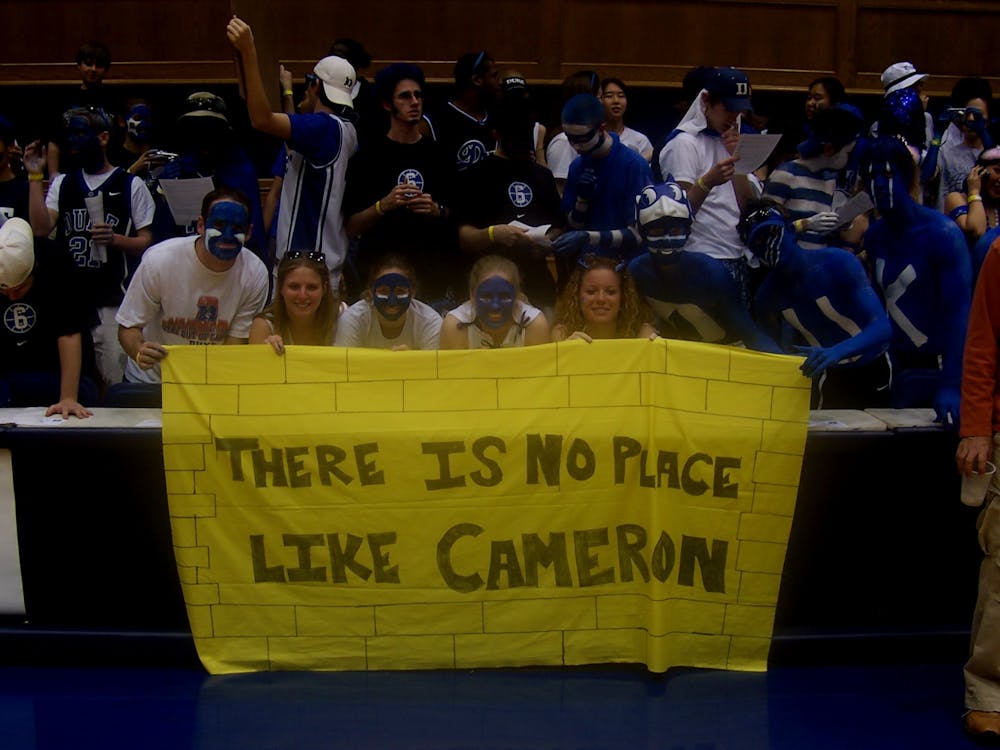
“All the students just really leaned super hard into a ‘Wizard of Oz’ theme, because Roy wasn't in Kansas anymore,” Baum said. “There were people in full ‘Wizard of Oz’ outfits all throughout the student section, and we all learned the ‘Rock Chalk, Jayhawk’ chant so that we could do it during the game.”
The Crazies pulled off the joke without any formal planning. Once a group of senior tenters mentioned the idea in K-Ville, Baum’s tent secured yellow fabric. Student creativity blossomed from there, and the collective effort delivered a memorable game.
That same dedication to the Duke-North Carolina rivalry made Baum’s job as a line monitor more difficult. Ahead of the game, he caught students sleeping in Cameron and sneaking through the tunnels dressed as managers. While he turned them away, he did his best to pack Section 17 with as many tenters as possible.
“We would swipe every third card or so backwards,” Baum explained, “so that when the fire marshal came and said, ‘It's too full’ ... we were still way under capacity.”
‘Our team’
Not much has changed in Section 17 since Baum and the baby’s birth. Athletics replaced the bleachers, getting the cheapest ones they could find. Cheaper bleachers were narrower, and they fit two extra rows in the same space. The traditions begun by the Boggers are staples in a choreographed attack each game, led by the students painted blue. They still don’t sit, even if only for the fact that there isn’t room.
While dirt sheets are now comprehensive, the Crazies still have their spontaneous moments. After Reed’s daughter, Erika Pietrzak, was thrown out of a 2024 game against Notre Dame, her classmates began chanting “FREE BANANA,” in reference to the fruit-themed costume she always wore to games. The rigor of tenting also allows for more collaboration with the program; Sion James and Stanley Borden, along with Krzyzewski’s daughter Debbie Savarino, were the judges for the first-ever K-Ville talent show. While the relationship looks different now than when Krzyzewski had the Boggers at his house for backyard barbecues, the two rely on each other.
“I always refer to them as ‘our team,’” Krzyzewski said of the Crazies.
Peters, Dipierro’s roommate, was with her in the rafters that rainy night when the Crazies slept inside Cameron. In their four years, the two tented together, heckled behind the opponents bench together, attended “The Shot” game in Philadelphia and witnessed their team bring home a national championship while standing on their home court.
Peters passed away in 2017 due to cancer, and Dipierro began collecting photos and recalling memories. She realized that nearly all of them had a common theme: Duke basketball. She wrote down her memories with Peters and their time in Cameron Indoor and Krzyzewskiville, and she sent an email of gratitude to Krzyzewski.
“We remember your talks before the Carolina games, sleeping in the rafters at Cameron in the pouring rain and the two national championships, watching them on the big screen in Cameron,” Dipierro said she wrote in the letter. “I don't have her anymore to do that with, but I have those memories that we made together, and they were all possible because of Duke basketball.”
Krzyzewski wrote back. “We always respond,” he said. “Duke basketball and the Duke student body are one.”

Rachael Kaplan is a Trinity senior and a senior editor of The Chronicle's 120th volume.

Abby DiSalvo is a Trinity sophomore and assistant Blue Zone editor of The Chronicle's 120th volume.

